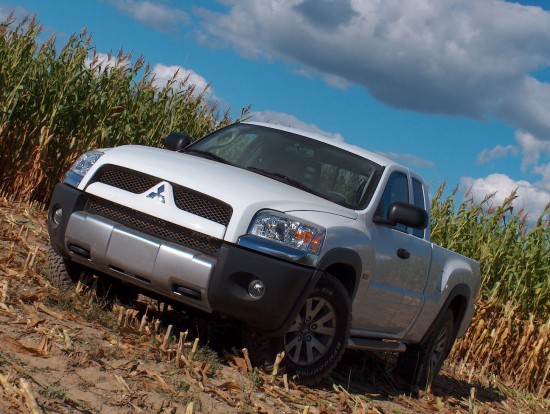2006 Mitsubishi Raider
Hoping To Raid The Midsize Truck Market
“Sure thing, drop it off, gotta go!” I exclaim to the Mitsubishi PR guy as quickly as I can while trying to hammer out the final details of an important business meeting as I am walking into it with two colleagues.
“What was that all about?” one colleague inquires.
“We get a Mitsu Raider for the weekend, so if we…”
In the aftermath of that morning I ended up with an Arctic White midsize pickup to which I was granted the keys for the bulk of the long weekend. But first things first: load up the boys, lets go go-karting. Nothing like channeling out the week’s frustration by running a few hot laps around a winding course strapped to a 5.5-hp go-cart in a semi-competitive manner. (Semi only because they don’t allow “bumping”) Yours truly managed to pull off the third fastest lap of the evening, bested only by a fellow enthusiast, who has been drifting cars since before he could chew solid foods, and the guy who was voted back seat occupant of the Raider on the trip down (I think he was gunning for me after that). Good fun if you have a competitive group that doesn’t mind coughing up a little dough for a fun filled evening.
I suppose you wonder how that relates to the new Dodge Dakota-based truck from ailing Mitsubishi. It doesn’t. But I did get some first-hand rear seat impressions and I didn’t have to go back there! This is significant because the rear seat is nothing more than two separate jump seats mounted on the rear wall. Legroom is non-existent, the seatback is 90-degrees to the floor pan, and the cushions are about an inch thick. Briefcases and duffle bags should be the only things allowed back there. Front seat room is more than adequate and the chairs felt well sculpted. The instrument panel receives some minor tweaking from that of the Dakota, with the three-point star affixed to the airbag cover and the word Raider molded into the dash. The standard Chrysler radio head unit carries over, as well as the Dakota’s white-faced instruments. The gauges are large and easy-to-read and at night they glow like a Timex watch. The leather wrapped steering wheel drew praise, but placement of the 4-wheel drive controls and passenger airbag deactivation switch wrinkled the forehead. Both were out of reach and out of sight of the driver’s vantage point. In fact, it was easier to reach back and open the rear-sliding window than it was to engage 4-high. Dash materials are comprised mainly of hard molded plastic, but are blended together fairly smoothly with splashes of metallic-look trim to breakup the gray plastic. The steering wheel is leather wrapped with spoke mounted cruise control buttons. In retrospect, the extended cab provides some much needed interior storage room and makes a nice fit for a pair of duffle bags for my Labor Day weekend escape. Spring for the Double-cab, however, if you intend on ever regularly having more than two passengers.
Commentators predominantly preferred the more muscular and rounded look of the Raider vs. that of the Dakota. We’ll give credit to Dodge and Mitsubishi for doing a much better job at differentiating their respective models than GM has ever done with any of its Chevy/GMC trucks. Fenders are flared out more than those of the Dakota, while the hood and light fixtures are also unique to the Mitsu. It may be a bit of a stretch to call this thing aerodynamic, but at least the lines flow and blend together in a manner not all that dissimilar to the new Eclipse. Our truck being of the DuroCross 4wd variety came equipped with 16-inch machined aluminum wheels wrapped in aggressive BFGoodrich all-terrain tires. They were bit noisier than your standard road tire, but came in handy while motoring around the farm country.
Speaking of motoring. Our truck was equipped with the optional 4.7-liter V8 and 5-speed automatic transmission that comes attached to that engine. This combo is well matched, though the tranny seemed reluctant to shift at times, holding gears maybe just a bit longer than necessary, ideal when loaded, but a waste otherwise. With 230hp and 290 lb-ft of torque the Raider was not lacking muscle. Ride and handling were on par for your standard pick-up truck. Lack of weight in the rear end made for some tail happy skipping over washboard surfaces, frost heaves, and expansion joints. Nothing unexpected anyways, considering the configuration combined with the off-road ready tires and shock and suspension setup. All in all, it was a pleasure kicking the trails and kicking up dust with the Raider.
Then I had to part ways with my Arctic White 4×4. While not comprised of the plushest materials or the finest dynamic tuning, it was easy to become attached to it. Like an old pair of shoes that you found in the closet, fascinated at how well they still fit. If you’re interested you will soon have your chance for a fitment when the Raider goes on sale at the end of September. Pricing hasn’t yet been announced, but expect to pay close to that of a similar Dakota, starting around the $22,000 mark. Throw in the added bonus of a 5-year warranty and the Raider becomes even more deserving of a good look.
| The Good: |
| Fresh styling, smooth engine, fun and workable. |
| The Bad: |
| Rear seats are a joke, hard plastic abounds, poor control placement. |
| The Verdict: |
| The freshest looking truck on the market has solid mechanicals and a great warranty too. |



















